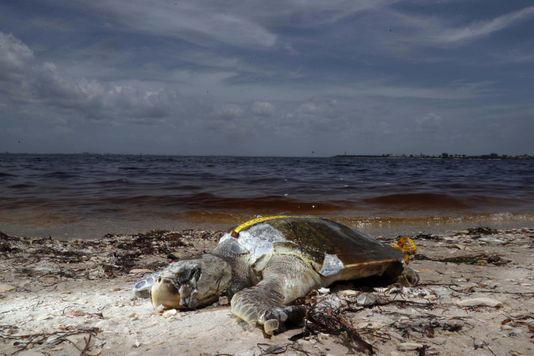Florida declares a state of emergency as red tide kills animals and disrupts tourism.
The red tide outbreak in Florida has left many travelers wondering if they should seek a beach holiday elsewhere.
What is being called the worst toxic algae bloom in years has been killing turtles, manatees, dolphins, and other marine life. It is also creating respiratory and gastrointestinal issues for humans. Many of Florida’s popular west coast beaches from Tampa Bay to Sarasota to Naples are practically deserted as the red tide emits toxic gases.
According to the Florida Fish and Wildlife Conservation Commission, red tide is a naturally-occurring microscopic alga that has been documented along Florida’s Gulf Coast since the 1840s.
Blooms, or higher-than-normal concentrations of the red tide alga, known as Karenia brevis, happen nearly every year in the Gulf of Mexico. Red tide begins in the Gulf of Mexico 10 to 40 miles offshore but can move inshore thanks to winds and currents.
“FWC is aligning our resources with the needs of local communities as we work together to manage this important issue,” says Eric Sutton, executive director of the Florida Fish and Wildlife Conservation Commission. “Keeping the public informed by providing updated information is a priority.”
The Fish and Wildlife Research Institute, part of the commission, studies dozens of water samples every week and shares what it finds with the public. Since this particular bloom began last November, the institute has processed more than 7,600 water samples. In past outbreaks over the last 20 years, fish and fisheries have been able to rebound, the commission says.
Are Florida’s algae blooms making people sick?
Larry Brand, professor of marine biology and fisheries at the University of Miami, says it’s difficult to tell why this outbreak has been so bad, but Hurricane Irma last year and a particularly rainy fall and winter have contributed to the outbreak.
There has also been speculation that over-development and climate change are factors as well.
Brand says it is also hard to predict how long the outbreak will last but that it will most likely go through the rainy season, which can extend into November.
His advice to people who want a Florida beach holiday? “If people want to go to the beaches, go to the east coast,” he says.
Last month, Florida Gov. Rick Scott declared a state of emergency in Palm Beach, Martin, St. Lucie, Glades, Hendry, Lee, and Okeechobee counties.
Travelers who have made plans to travel to those counties should check the cancellation policies of their hotels and the change fees for their flights.
For now, people should avoid swimming and eating any seafood from the affected beaches on the west coast, Brand says.
“The toxin gets up in the air,” he says. “If you go down to the beach, you’re breathing that in. It’s a neuro-toxin. It’s like a tear gas. Your eyes will start watering, you may start coughing and so on.”
Brad Dalton, deputy press secretary in the Office of Communications at the Florida Department of Health, says the eye, nose and throat irritation typically goes away once a person leaves an area with red tide.
“If you have symptoms, leave the beach and seek air conditioning,” he says. “If symptoms persist, please seek medical attention. People with severe or chronic respiratory conditions such as asthma or chronic lung disease are cautioned to avoid areas with active red tides.”
People can check on the red tide conditions of a particular beach by going to the Florida Fish and Wildlife Conservation Commission Research Institute Red Tide Conditions Report. The commission publishes the report on Wednesdays and Fridays.
Mote Marine Beach Conditions Report is another good resource.
Illnesses from red tide exposure should be reported to Florida’s Poison Control Center at 800-222-1222.
For more information on red tide, visit Floridahealth.gov/environmental-health/aquatic-toxins/red-tide.html.


Recent Comments